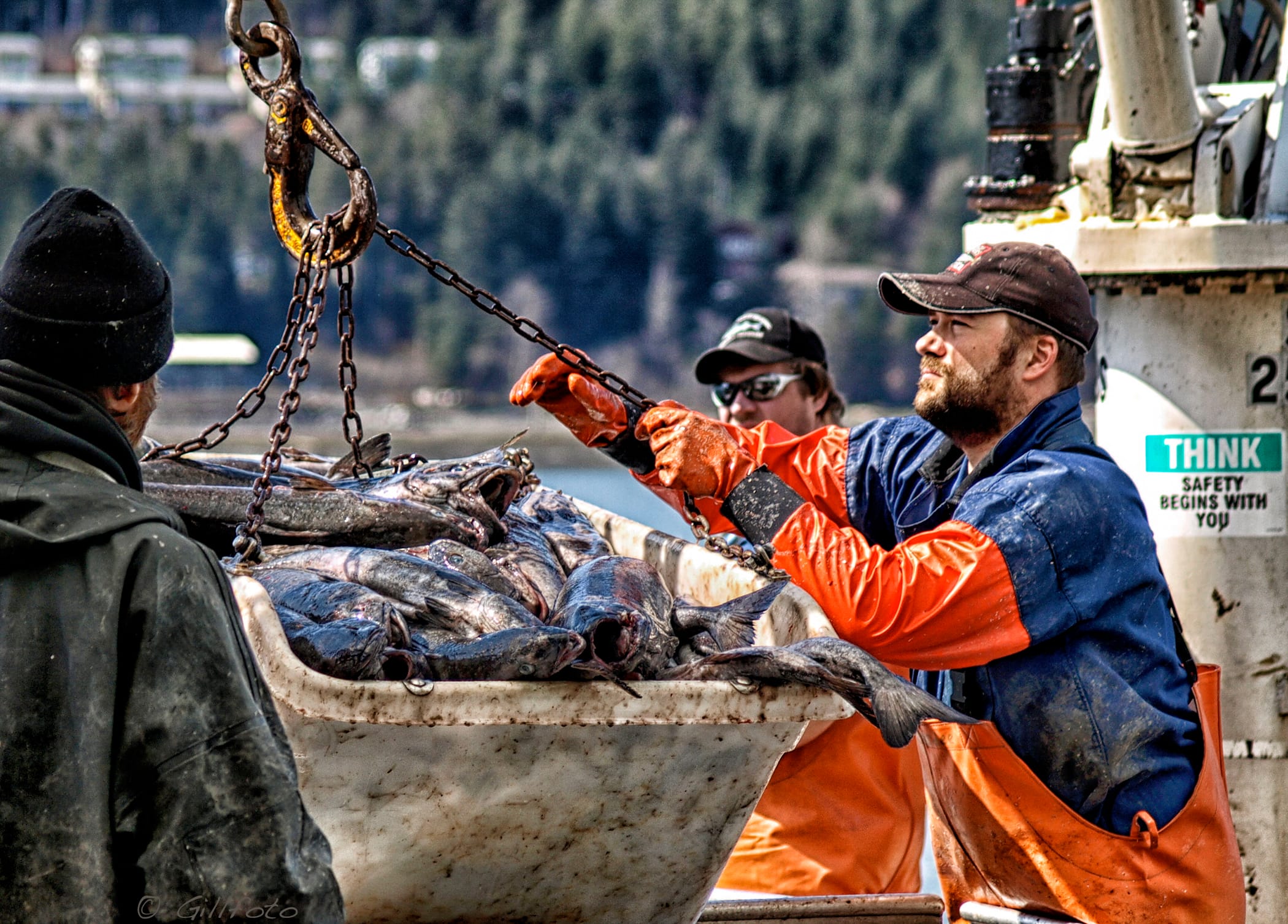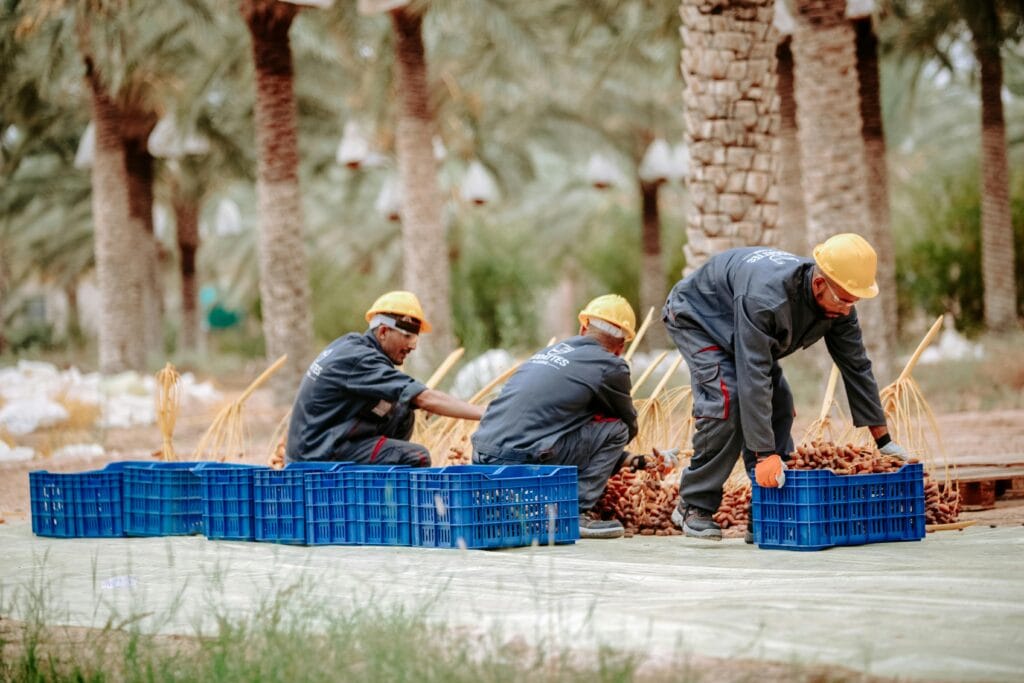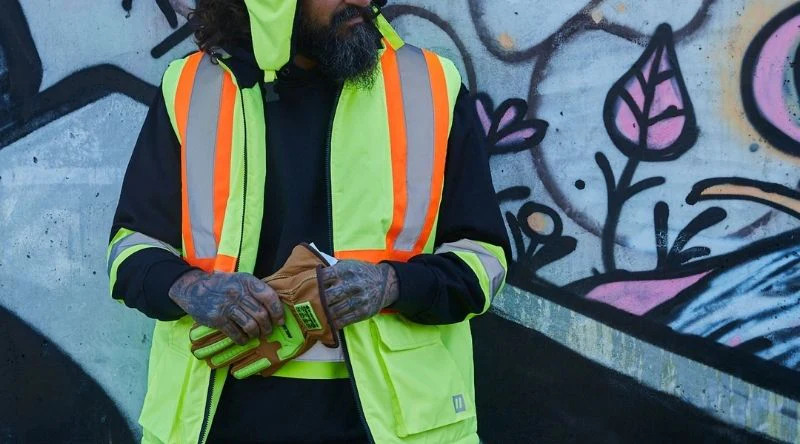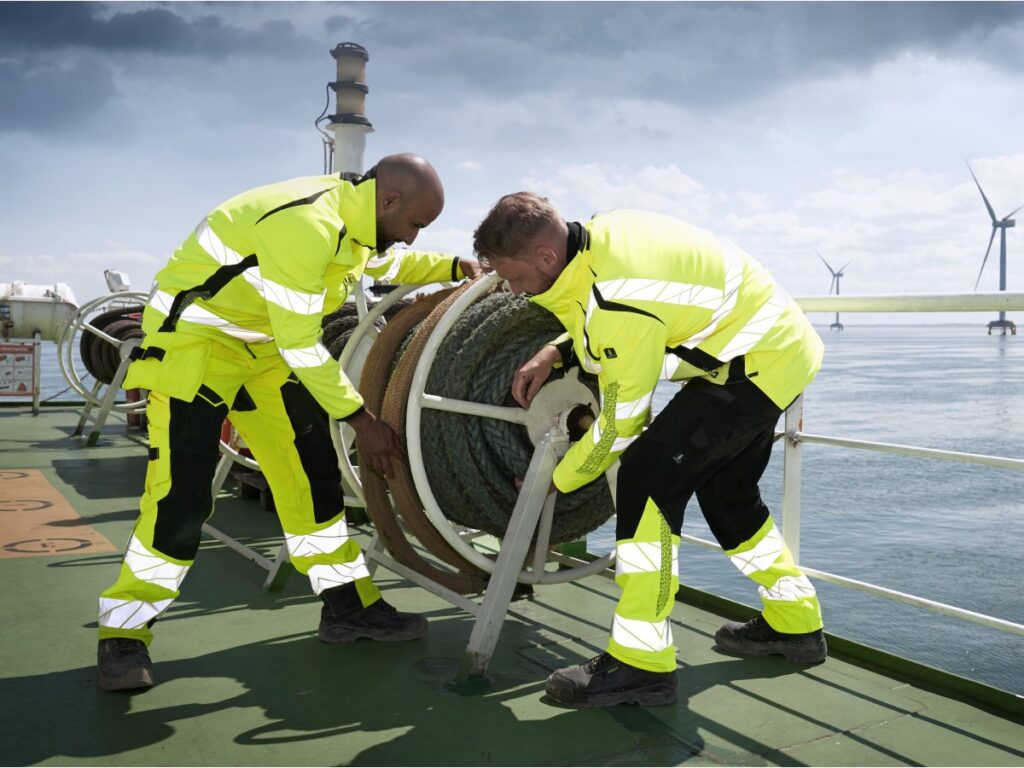
Fishing and port industries in Latin America are the lifeline of economies in Peru, Chile, Ecuador, Brazil, and Argentina. From tuna fleets in the Pacific to shrimp farms in Brazil and container ports in Buenos Aires, millions of workers face wet, salty, and high-risk environments every day.
Constant exposure to seawater, fish oils, cleaning chemicals, and heavy lifting equipment creates unique hazards: slips, hypothermia, chemical burns, skin infections, and even drowning. The right workwear is not optional—it’s a survival tool.
Latin American fishing and port workwear must prioritize waterproofing, slip resistance, chemical protection, and insulation. Essential items include PVC-coated rain suits, slip-resistant rubber boots, neoprene or nitrile gloves, insulated jackets, high-visibility vests, and corrosion-resistant safety gear. Materials should be non-porous, quick-drying, and compliant with EN ISO 343 (protection against rain) and EN ISO 20345 (safety footwear).
Why Fishing & Port Work Require Specialized Workwear
- Constant Moisture & Salt Exposure → Increases risk of skin infections, gear degradation, and hypothermia.
- Heavy Machinery & Slippery Surfaces → Dock workers handle containers, cranes, and forklifts in wet areas, requiring high traction footwear.
- Chemical Contact → Fish processing often uses strong cleaners; gloves and aprons must resist caustic solutions.
- Cold & Windy Environments → Especially in Chilean and Argentine ports, where workers spend long hours outdoors.
- Visibility & Safety → Workers around ships and trucks need high-visibility clothing to avoid accidents.
Real-World Accident Cases
Case #1 – Shrimp Farm, Ecuador
A worker wore cotton trousers while standing in ponds for hours. Fabric absorbed water, causing skin infections and fungal diseases.
Solution: Company issued PVC-coated waterproof trousers and boots, reducing health-related absences by 70%.Case #2 – Fishing Port, Peru
Dockworker slipped on fish oil while unloading crates, fracturing his leg.
Fix: Slip-resistant nitrile boots were introduced, preventing similar accidents in the following season.Case #3 – Salmon Processing Plant, Chile
Worker using bare hands to clean equipment with caustic soda developed severe chemical burns.
Prevention: Company switched to nitrile chemical-resistant gloves, lowering chemical injury cases to nearly zero.Case #4 – Port of Santos, Brazil
Crane operator wearing a dark jacket at night was nearly struck by a reversing truck.
Improvement: Mandatory high-visibility vests with reflective strips were introduced.
Workwear Standards Relevant to Fishing & Port Industries
| Standard / Regulation | Purpose |
|---|---|
| EN ISO 343 | Waterproofing and breathability of protective clothing |
| EN ISO 20345 | Safety footwear requirements (slip resistance, toe protection) |
| EN ISO 13688 | General protective clothing requirements |
| EN 374 | Chemical-resistant gloves for cleaning agents |
| ANSI/ISEA 107 | High-visibility safety apparel |
| Local Maritime Safety Codes | Port-specific work safety regulations (varies by country) |
🌎 Note: Even if local rules are less strict, exporters and multinational port operators often require compliance with EU or ANSI standards for credibility and liability protection.
Key Workwear Items for Fishing & Ports
| Item | Primary Purpose | Recommended Material |
|---|---|---|
| Waterproof Rain Suits | Full-body protection from seawater & rain | PVC, PU-coated polyester |
| Slip-Resistant Boots | Prevent falls on wet/slippery surfaces | Nitrile or PVC with SRC slip rating |
| Chemical-Resistant Gloves | Handling fish oils & caustic cleaners | Nitrile, neoprene |
| Insulated Jackets | Protection from cold winds & moisture | PU-coated fabrics with thermal lining |
| High-Visibility Vests | Visibility near cranes & trucks | Polyester mesh with reflective tape |
| Aprons (Fish Processing) | Protection from oils & scales | PU-coated polyester, PVC |
| Safety Goggles | Protect eyes from splashes & chemicals | Anti-fog polycarbonate |
✅ Tip: Footwear must be both waterproof and non-slip—a common mistake is buying cheap rubber boots with no SRC rating.
Material Selection Tips
- PVC & PU Coatings → Best for waterproofing and easy cleaning; ideal for rain suits and aprons.
- Nitrile / Neoprene Gloves → Strong resistance against fish oils, detergents, and chemicals.
- Thermal Insulated Fabrics → Prevent hypothermia during long shifts in cold winds.
- High-Visibility Polyester → Lightweight and reflective for night shifts.
- Anti-Fog Polycarbonate → Goggles that don’t mist up in humid environments.
⚠️ Avoid cotton garments in production areas—they absorb water, oils, and bacteria, leading to contamination and infections.
Layering Strategy for Wet & Cold Port Conditions
- Base Layer: Moisture-wicking polyester shirt to stay dry.
- Mid Layer: Insulated fleece or padded vest for warmth.
- Outer Layer: Waterproof PVC-coated rain jacket or insulated coat.
- Accessories: Slip-resistant boots, gloves, goggles, and high-visibility vest.
This system keeps workers warm, dry, and visible, reducing fatigue and accidents.
Procurement Mistakes to Avoid
- Choosing Non-Breathable Gear: Workers sweat heavily inside sealed PVC suits, causing discomfort and heat stress.
- Ignoring Slip Ratings on Boots: Many cheap boots are “waterproof” but fail under fish oil and seawater conditions.
- Reusing Disposable PPE: Disposable aprons and gloves reused for cost savings → contamination risk.
- Buying Unsuitable Insulation: Thick Arctic gear sold to tropical ports like Guayaquil leads to overheating.
- Skipping Customization: Many port operators want logos on uniforms for professional branding.
Cost-Benefit Analysis
| Scenario | Without Proper Workwear | With Correct Workwear | Annual Savings |
|---|---|---|---|
| Slip injuries on docks (Peru) | $4,000 per case × 10 cases | $35 per SRC-rated boot | $39,650 |
| Chemical burns from cleaners (Chile) | $1,500 per case × 20 workers | $20 per nitrile glove set | $29,600 |
| Hypothermia treatments (Argentina) | $800 per incident × 15 cases | $50 per insulated jacket | $10,700 |
| Contamination recalls (Ecuador fish export) | $100,000+ potential loss | $7,500 annual PPE spend | $92,500 |
👉 The math is clear: investing in certified waterproof and chemical-resistant workwear pays for itself many times over in reduced accidents, avoided recalls, and smoother export compliance.
Buyer FAQ
Q1: Can workers use regular raincoats instead of certified rain suits?
A: No. Regular raincoats are not designed for industrial environments. They lack durability, tear easily, and often trap sweat, creating health risks. Certified rain suits meet EN ISO 343 standards for both waterproofing and breathability.
Q2: Are slip-resistant boots really necessary?
A: Absolutely. Fish oils and seawater make port floors extremely slippery. Boots with SRC-rated soles dramatically reduce falls and related injuries.
Q3: How often should chemical-resistant gloves be replaced?
A: Gloves should be replaced as soon as signs of wear appear, or at least every season in high-use environments like fish processing plants.
Q4: Do all workers need high-visibility clothing?
A: Yes, especially in ports and shipyards where cranes, trucks, and forklifts operate around the clock. High-visibility vests prevent accidents during night shifts and low-light conditions.
Q5: Can we customize uniforms with company logos?
A: Yes. Many fishing companies and port operators request custom branding for identification, professionalism, and worker morale.
Procurement Checklist
- [ ] EN ISO 343-certified waterproof rain suits
- [ ] SRC-rated slip-resistant boots
- [ ] Nitrile or neoprene chemical-resistant gloves
- [ ] Insulated jackets for cold and windy environments
- [ ] High-visibility vests (ANSI/ISEA 107 compliant)
- [ ] PVC or PU aprons for fish processing areas
- [ ] Anti-fog safety goggles
- [ ] Regular PPE inspection and replacement schedule
- [ ] Custom logo printing for uniforms
Conclusion
Fishing and port work in Latin America demands tough, waterproof, and corrosion-resistant workwear. From shrimp farms in Ecuador to container docks in Brazil, the right gear keeps workers safe, visible, and productive in one of the harshest environments on earth.
Investing in certified PPE is not only a safety measure—it’s a guarantee of smoother operations, compliance with international buyers, and reduced accident costs.
📩 Need certified fishing & port workwear for your team or distribution business?
Email: [email protected]
🌐 www.workwearsolutions.net
Zion Zhang
Recent Posts
 Workwear for South American Agriculture: Durability, Comfort, and Compliance2025年9月12日Agriculture in South America is one of the world’s largest […]
Workwear for South American Agriculture: Durability, Comfort, and Compliance2025年9月12日Agriculture in South America is one of the world’s largest […] High-Visibility Workwear in African Infrastructure Projects: Safety, Standards, and Sourcing Opportunities2025年9月12日From Nairobi’s highways to Lagos’s ports and Addis Ababa’s […]
High-Visibility Workwear in African Infrastructure Projects: Safety, Standards, and Sourcing Opportunities2025年9月12日From Nairobi’s highways to Lagos’s ports and Addis Ababa’s […] Flame-Resistant Workwear in the Middle East Oil & Gas Industry: Safety, Standards, and Sourcing2025年9月11日In the deserts of Saudi Arabia, the offshore rigs of Qatar, […]
Flame-Resistant Workwear in the Middle East Oil & Gas Industry: Safety, Standards, and Sourcing2025年9月11日In the deserts of Saudi Arabia, the offshore rigs of Qatar, […] Workwear in Africa’s Construction Boom: Demand, Trends, and Opportunities2025年9月11日Walk through any African city today, and you’ll see […]
Workwear in Africa’s Construction Boom: Demand, Trends, and Opportunities2025年9月11日Walk through any African city today, and you’ll see […] PPE Distributor Success Stories: From Small Orders to Large Contracts2025年8月20日I’ll never forget the story of a small distributor in […]
PPE Distributor Success Stories: From Small Orders to Large Contracts2025年8月20日I’ll never forget the story of a small distributor in […] How to Build a Strong PPE Sales Channel in Emerging Markets: A Buyer’s Guide2025年8月20日I was in a meeting with a distributor from Lagos, Nigeria, […]
How to Build a Strong PPE Sales Channel in Emerging Markets: A Buyer’s Guide2025年8月20日I was in a meeting with a distributor from Lagos, Nigeria, […]
CONTACT US
- Feel free to contact us any time. We will get back to you as soon as we can!
- +86-17330061805
